EC number 1.4.1.2 ExPASy NiceZyme view | CAS number 9001-46-1 | |
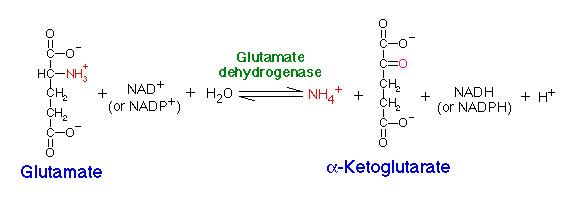 | ||
Protein amino acid metabolism part 4 of 8 glutamate dehydrogenase gldh
Glutamate dehydrogenase (GLDH) is an enzyme, present in most microbes and the mitochondria of eukaryotes, as are some of the other enzymes required for urea synthesis, that converts glutamate to α-ketoglutarate, and vice versa. In animals, the produced ammonia is usually used as a substrate in the urea cycle. Typically, the α-ketoglutarate to glutamate reaction does not occur in mammals, as glutamate dehydrogenase equilibrium favours the production of ammonia and α-ketoglutarate. Glutamate dehydrogenase also has a very low affinity for ammonia (high Michaelis constant
Contents
- Protein amino acid metabolism part 4 of 8 glutamate dehydrogenase gldh
- Glutamate dehydrogenase catabolism of glutamate
- Clinical application
- Cofactors
- Role in flow of nitrogen
- Regulation of glutamate dehydrogenase
- Regulation
- Isozymes
- References

The enzyme represents a key link between catabolic and anabolic pathways, and is, therefore, ubiquitous in eukaryotes. In humans the relevant genes are called GLUD1 (glutamate dehydrogenase 1) and GLUD2 (glutamate dehydrogenase 2), and there are also at least 8 GLDH pseudogenes in the human genome as well, probably reflecting microbial influences on eukaryote evolution.
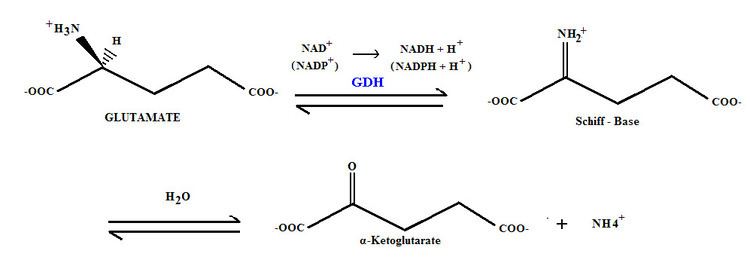
Glutamate dehydrogenase catabolism of glutamate
Clinical application
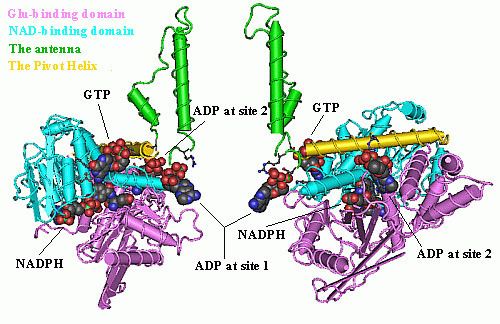
GLDH can be measured in a medical laboratory to evaluate the liver function. Elevated blood serum GLDH levels indicate liver damage and GLDH plays an important role in the differential diagnosis of liver disease, especially in combination with aminotransferases. GLDH is localised in mitochondria, therefore practically none is liberated in generalised inflammatory diseases of the liver such as viral hepatitides. Liver diseases in which necrosis of hepatocytes is the predominant event, such as toxic liver damage or hypoxic liver disease, are characterised by high serum GLDH levels. GLDH is important for distinguishing between acute viral hepatitis and acute toxic liver necrosis or acute hypoxic liver disease, particularly in the case of liver damage with very high aminotransferases. In clinical trials, GLDH can serve as a measurement for the safety of a drug.
Cofactors
NAD+(or NADP+) is a cofactor for the glutamate dehydrogenase reaction, producing α-ketoglutarate and ammonium as a byproduct.
Based on which cofactor is used, glutamate dehydrogenase enzymes are divided into the following three classes:
Role in flow of nitrogen
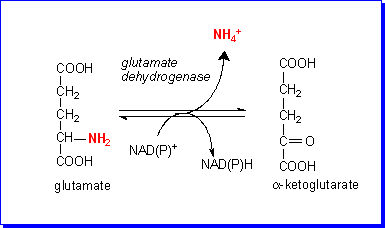
Ammonia incorporation in animals and microbes occurs through the actions of glutamate dehydrogenase and glutamine synthetase. Glutamate plays the central role in mammalian and microbe nitrogen flow, serving as both a nitrogen donor and a nitrogen acceptor.
Regulation of glutamate dehydrogenase
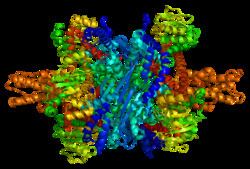
In humans, the activity of glutamate dehydrogenase is controlled through ADP-ribosylation, a covalent modification carried out by the gene sirt4. This regulation is relaxed in response to caloric restriction and low blood glucose. Under these circumstances, glutamate dehydrogenase activity is raised in order to increase the amount of α-ketoglutarate produced, which can be used to provide energy by being used in the citric acid cycle to ultimately produce ATP.
In microbes, the activity is controlled by the concentration of ammonium and or the like-sized rubidium ion, which binds to an allosteric site on GDH and changes the Km (Michaelis constant) of the enzyme.
The control of GDH through ADP-ribosylation is particularly important in insulin-producing β cells. Beta cells secrete insulin in response to an increase in the ATP:ADP ratio, and, as amino acids are broken down by GDH into α-ketoglutarate, this ratio rises and more insulin is secreted. SIRT4 is necessary to regulate the metabolism of amino acids as a method of controlling insulin secretion and regulating blood glucose levels.
Bovine liver glutamate dehydrogenase was found to be regulated by nucleotides in the late 1950s and early 1960s by Carl Frieden. In addition to describing the effects of nucleotides like ADP, ATP and GTP he described in detail the different kinetic behavior of NADH and NADPH. As such it was one of the earliest enzymes to show what was later described as allosteric behavior.
Mutations alter the allosteric binding site of GTP cause permanent activation of glutamate dehydrogenase lead to disorder known as hyperinsulinism-hyperammonemia.
Regulation
This protein may use the morpheein model of allosteric regulation.
Allosteric inhibitors:
Activators:
Additionally, Mice GDH shows substrate inhibition by which GDH activity decreases at high glutamate concentrations.
Isozymes
Humans express the following glutamate dehydrogenase isozymes:
